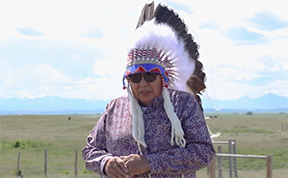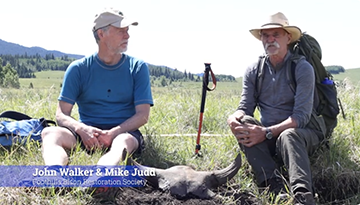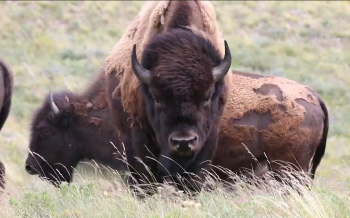Image Caption
Summary
Local Journalism Initiative Reporter
Windspeaker.com
A pipe ceremony later this month will bring Blackfoot Elders together with settlers in a shared goal to have bison once more roam public lands in Treaty 7 territory in southern Alberta.
It’s spiritual. It’s environmental. It’s protecting Mother Earth. And it’s a tangible act of reconciliation, says Kainai Elder Charlie Fox.
“When you look at the buffalo that were removed from this part, it was all planned. It was a planned takeover of our lands and they did that by taking the bison away and we were starving. We were on our knees. We had to abide by their wishes at the time, back in history,” said Fox.

“So today, when everybody's all gung-ho about reconciliation, these things were taken away from us, the bison. And in reality, if there's something you can do that's even tangible, you need to return the bison to their natural habitat so that they can revive or somewhat restore our climate or add to that.”
Mike Judd will host that pipe ceremony at his home in the foothills 40 kilometres south of the public lands that are being targeted to host a new herd of bison.
About a year ago, Judd and three other conservationists were hiking in Bob Creek Wildland Park, talking about what it would have been like with bison on the landscape.
“The next day on our way out, there was a great big bison skull that we came across right in the riverbed and we all took it as a sign that maybe there was something we could do about bringing them back,” said Judd.
He also sees the return of the bison as a tangible act of reconciliation.
“There is much talk about reconciliation and acknowledgement that we're on Treaty 7 lands. But in our opinion, there is not really much that's being done that is really concrete action to involve and share the landscape with First Nations in ways that could be,” he said.
From the hike in Bob Creek Wildland Park, the discovery of the bison skull, and discussion with people on both the Piikani and Kainai Nation, the Foothills Bison Restoration Society was formed.
Bison are regarded as a keystone species of the Plains.
“They're a creature that has a disproportionately large effect on the environment that they're in,” said Judd.
Fox points out that when 40 bison were released on the Kainai Nation in 2021 they brought with them “a lot of wildlife that are starting to flourish here. Very, very small, but you can see that.”
Scientists are finding, adds Judd, that drought resilient plants, insects, birds and some predators all begin returning where bison are restored.
“What's amazing,” he said, “is we don't really know what's missing off of the Prairie and the grassland landscapes since the bison disappeared 150 years ago.”
Mother Earth needs to be protected, says Fox, and the bison play an integral role in that.
“As a country, it's all these fires over the summer, really bad, and it created a lot of health issues, and now it's going to be floods. These things are just never ending. Everything's all connected and, if we can't understand that, it's going to be a hard lesson to learn again. I think we need to support any efforts to maintain our environment and (bison) are, in our way, spiritual,” said Fox.
Judd believes that Albertans love wilderness and they love wildlife, but there’s a “constant conflict with our landscape” which is being lost steadily to industrialization and recreational ventures.
“We're not really doing our share of protecting and restoring what should be there. So we're seeing (restoring bison) as a positive step towards at least doing some of that,” he said.

And the Bob Creek Wildland Park is the ideal place to reintroduce bison, says Judd. As the biggest protected montane landscape, the park on Alberta’s Eastern Slopes is more than 51,000 acres and sits north of the Crowsnest Pass area between the Livingstone Range, the Oldman River, and Highway 22.
“We'll never restore climate change. That's not going to happen in this lifetime. But this at least still helps towards that cause,” said Fox.
Judd anticipates the bison would come from Elk Island National Park as Parks Canada has worked with First Nations and Métis communities to introduce more than 300 bison back into their traditional territories in Alberta.
He says preliminary talks have not yet begun with the provincial government about bringing back the bison to the Bob Creek Wildland Park.
The Foothills Bison Restoration Society is now raising funds to undertake a feasibility study. Judd expects such a study, which will include wildlife biologists and First Nations advisors, will cost $30,000 to $50,000.
“The intent, the whole exercise…(is) now there's people that have decision-making powers. Now is their opportunity to put their money where their mouth is, so to speak,” said Fox.
A GoFundMe page, set up to raise the dollars, features a two-and-a half-minute video on the bison called “Coming Home.” To date, $4,000 has been donated. The full eight-minute video can be viewed above.
Local Journalism Initiative Reporters are supported by a financial contribution made by the Government of Canada.

